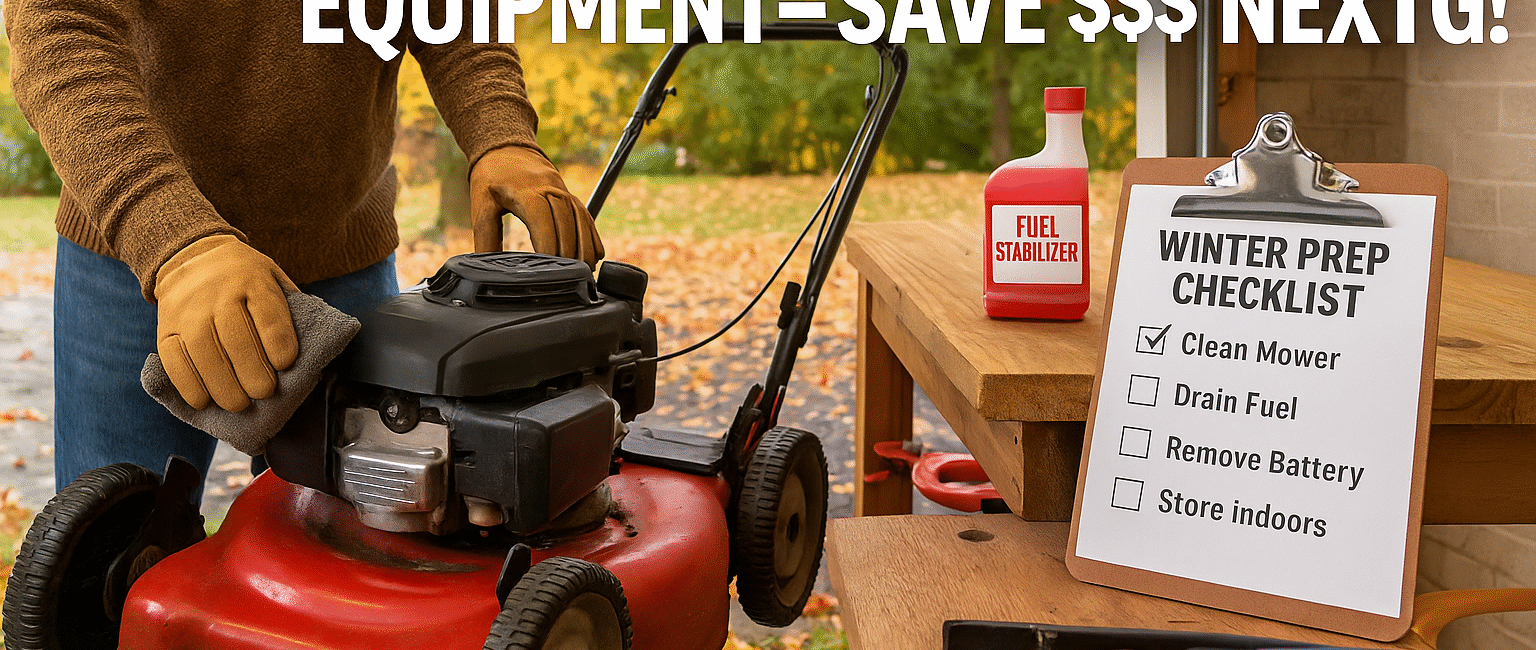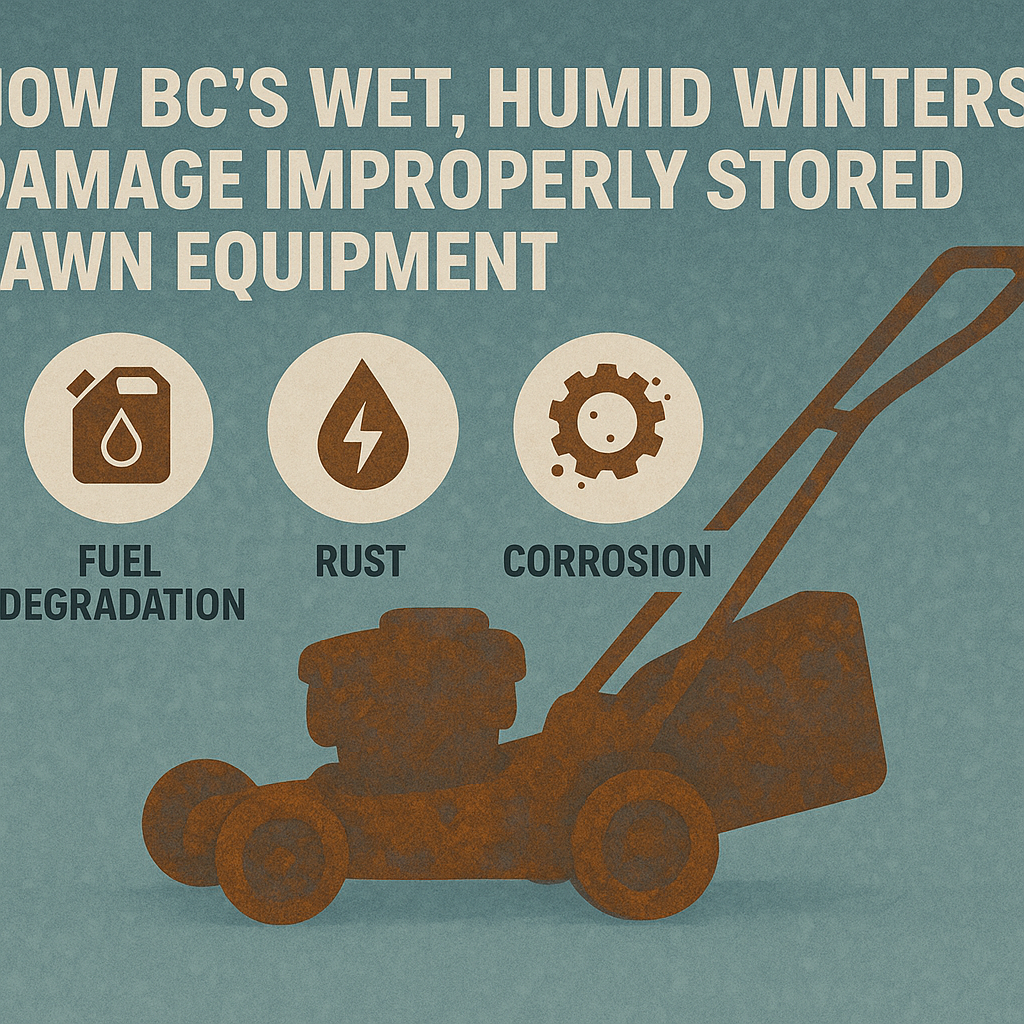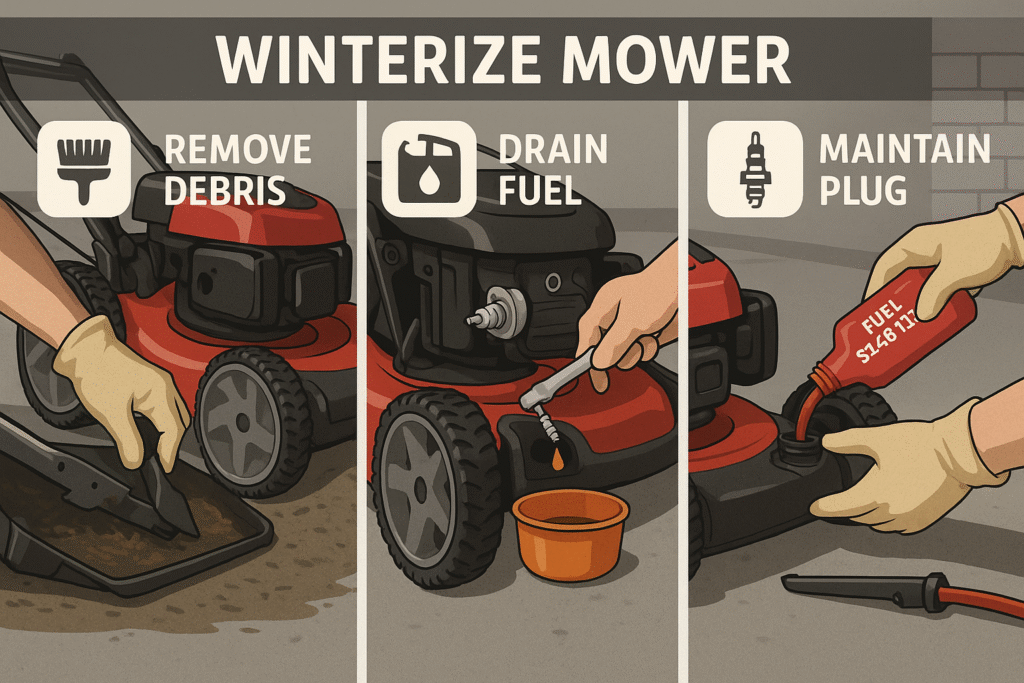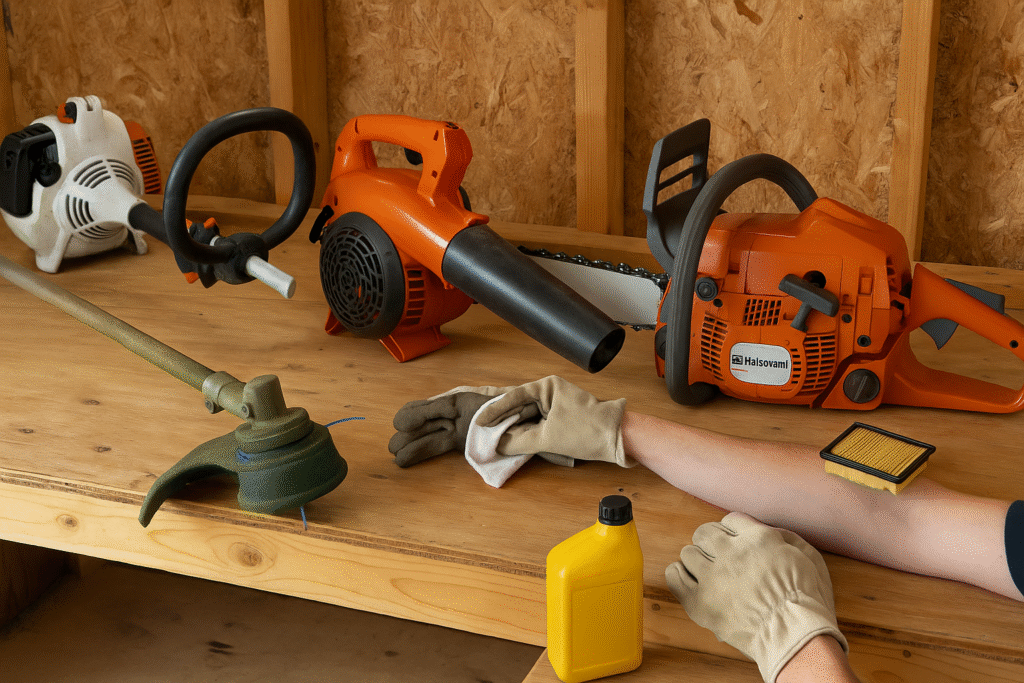
As the leaves start turning golden across British Columbia and that familiar Pacific Northwest chill creeps in, it’s time to think about putting your lawn equipment to bed for the winter. Whether you’re in Surrey, Vancouver, Burnaby, or anywhere in the Fraser Valley, proper winterization of your lawn tools can save you hundreds of dollars in repairs and ensure your equipment fires up ready to go come spring.
Let’s face it – BC winters can be tough on outdoor equipment. From the coastal rains in Vancouver to the freezing temperatures in the Interior, your mower, trimmer, and other lawn tools need proper care to survive until next growing season.
🔧 Why Winterizing Your Lawn Equipment Matters in BC
British Columbia’s unique climate presents specific challenges for lawn equipment storage. Our wet winters, temperature fluctuations, and high humidity can wreak havoc on small engines, metal components, and fuel systems. Proper winterization isn’t just recommended – it’s essential for:
- Preventing costly engine damage from fuel degradation
- Avoiding rust and corrosion from moisture exposure
- Ensuring reliable spring startup after months of storage
- Extending the overall lifespan of your investment

🏠 Mower Storage Tips: Getting Your Lawn Mower Winter-Ready
Your lawn mower is likely your most expensive piece of lawn equipment, so it deserves special attention during winterization.
Clean Before You Store
Start by giving your mower a thorough cleaning. Remove all grass clippings, dirt, and debris from the deck, engine, and air intake areas. Pay special attention to the underside of the deck where moisture can get trapped. A clean mower is less likely to develop rust and corrosion during BC’s damp winter months.
Use a garden hose to wash the deck, but avoid spraying water directly into the engine or air filter. For stubborn debris, a putty knife or wire brush works wonders.
Fuel System Preparation
This is where many BC homeowners make costly mistakes. You have two options for fuel preparation:
Option 1: Add Fuel Stabilizer
Fill your tank with fresh gasoline and add a quality fuel stabilizer like STA-BIL. Run the engine for 5-10 minutes to circulate the treated fuel throughout the system. This prevents fuel from going stale and gumming up your carburetor.
Option 2: Complete Fuel Removal
Some experts prefer completely draining the fuel system. Run the mower until it’s out of gas, then start it periodically until it won’t start anymore. This ensures no old fuel remains to cause problems.
Oil and Filter Changes
Change your mower’s oil before storage – used oil contains contaminants that can damage your engine over time. If your mower has an oil filter, replace that too. Fresh oil provides better protection against corrosion during long-term storage.
Spark Plug Care
Remove the spark plug and inspect it for wear or fouling. Clean it with a wire brush or replace it if necessary. Add a tablespoon of oil to the cylinder through the spark plug hole, then pull the starter cord a few times to distribute the oil. This prevents cylinder walls from rusting.
Battery Maintenance (for Electric Start Models)
If your mower has an electric start, remove the battery and store it in a cool, dry location. Consider using a battery tender to maintain proper charge levels throughout the winter.

✂️ Winterizing String Trimmers and Other Small Equipment
Don’t forget about your string trimmer, leaf blower, and chainsaw – these tools need winter prep too.
String Trimmer Winterization
Empty the fuel tank or add stabilizer, just like with your mower. Clean the air filter and inspect the cutting head for damage. Remove any old trimmer line and store the tool in a dry location.
Leaf Blower Care
Clean debris from the impeller housing and air intake. Check and clean the air filter, and don’t forget about fuel stabilization. For backpack blowers, inspect and clean the straps and harness.
Chainsaw Storage Tips
Clean the bar and chain thoroughly, then apply bar oil to prevent rust. Remove the chain and soak it in oil overnight before storage. Empty the fuel tank and clean the air filter.

🛠️ Hand Tools and Equipment Maintenance
Your rakes, shovels, and other hand tools deserve attention too. Clean all tools thoroughly and apply a light coat of oil to metal surfaces to prevent rust. Wooden handles benefit from an application of linseed oil to prevent cracking.
🏢 Indoor vs. Outdoor Storage Solutions for BC Weather
Indoor Storage (Recommended)
The best option for BC homeowners is storing equipment in a heated garage, basement, or shed. This protects against temperature fluctuations and moisture – two of the biggest threats to lawn equipment in our climate.
Outdoor Storage Considerations
If indoor storage isn’t possible, invest in a quality equipment cover or small storage shed. Ensure good ventilation to prevent condensation buildup, and consider using moisture absorbers like silica gel packets.
📅 Creating Your Pre-Spring Checklist
Before you fire up your equipment next spring, you’ll want to:
- Check and change fluids if needed
- Inspect air filters and spark plugs
- Test the battery (if applicable)
- Sharpen blades and cutting tools
- Check belts and cables for wear
💰 Professional Winterization Services in BC
Not comfortable doing the work yourself? Many BC lawn care professionals offer winterization services. This is especially valuable for expensive equipment or if you’re not mechanically inclined.
Professional services typically include complete fuel system cleaning, oil changes, blade sharpening, and comprehensive inspections. While it costs more upfront, professional winterization can prevent expensive repairs down the road.
🔍 Need Professional Help? Find Local Experts on BC Service Finder
Don’t want to tackle winterization yourself? No problem! Visit BCServiceFinder.ca to connect with experienced lawn equipment technicians in your area. Whether you’re in Surrey, Vancouver, Richmond, or anywhere else in BC, our platform helps you find qualified professionals who understand the unique challenges of our climate.
Get matched with local experts who offer:
- Complete equipment winterization services
- Spring tune-ups and maintenance
- Repair services for all major brands
- Mobile service options
Visit BCServiceFinder.ca today and ensure your lawn equipment gets the professional care it needs to survive another BC winter!
❓ Frequently Asked Questions
How early should I winterize my lawn equipment in BC?
Start winterizing your equipment by mid-October in most BC regions. Coastal areas like Vancouver and Surrey can often wait until early November, while Interior locations should begin by late September.
Can I use regular gasoline with fuel stabilizer, or do I need special fuel?
Regular gasoline with a quality fuel stabilizer works perfectly fine. Avoid gasoline with more than 10% ethanol (E10), as higher ethanol content can damage small engines over time.
Should I remove the mower blade for winter storage?
It’s not necessary to remove the blade, but it’s an excellent time to have it sharpened. A sharp blade makes for healthier grass cuts and easier mowing when spring arrives.
How do I prevent mice from nesting in my stored equipment?
Store equipment in sealed areas when possible, and consider using natural deterrents like peppermint oil-soaked cotton balls placed around (not in) your equipment. Remove any food sources from storage areas.
What’s the biggest mistake BC homeowners make when winterizing lawn equipment?
The most common mistake is neglecting fuel system preparation. Leaving untreated gasoline in equipment over BC’s long, damp winters almost guarantees carburetor problems and expensive repairs come spring.
Found this guide helpful? Please share it with your friends on Facebook so they can make better decisions about their lawn equipment care too! A little preparation now saves everyone money and frustration later. 🌟


